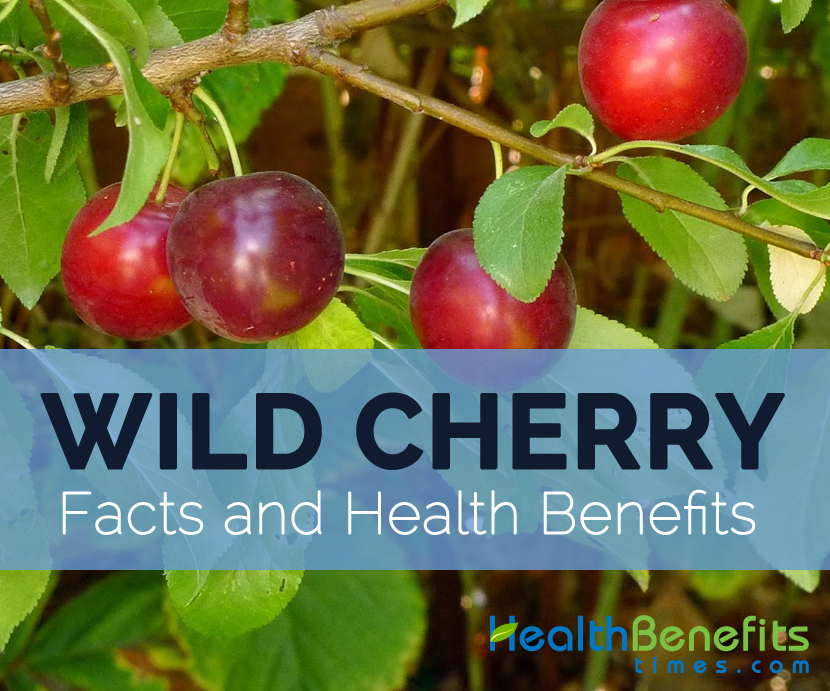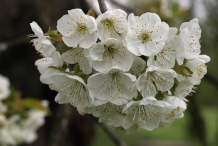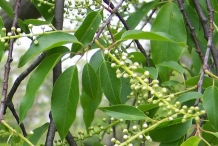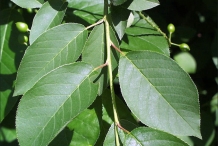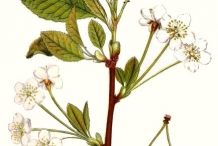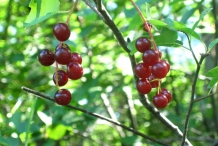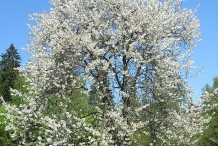| Wild cherry Quick Facts |
| Name: |
Wild cherry |
| Scientific Name: |
Prunus avium |
| Origin |
Mediterranean region such as eastern Europe/western Turkey |
| Colors |
Red to dark-red |
| Shapes |
Drupe, Diameter: 1–2 cm (0.39–0.79 inch) |
| Flesh colors |
Dark red |
| Taste |
Bitter |
| Calories |
97 Kcal./cup |
| Major nutrients |
Fluoride (77.50%)
Carbohydrate (18.97%)
Vitamin C (12.00%)
Copper (10.22%)
Dietary Fiber (8.42%)
|
| Health benefits |
Improves immunity, Prevents cancer, Eye Health, Mental health, Assist digestion |
Wild cherry is the edible fruit of the plant species in the genus Prunus L. of the Rosaceae family. Wild cherry is also called Bird Cherry, Bing cherry, Gean, Crab Cherry, Mazzard, Wild Cherry and Sweet Cherry. Wild cherry has different vernacular names which differs according to the country such as French: Merisier, Amèrise; Italian: Ciregiolo, Ciliegia Dolce; Spanish: Picota, Cerasus Dulce; Russian: Vishnia Ptich’ia, Chereshnia etc.
History
The cherry is native to Mediterranean region such as eastern Europe/western Turkey. By 800 BC., it was cultivated in Turkey then it was grown on all continents but Antartica.
Plant
Wild cherry is a large, deciduous and perennial tree, generally standing 15–32 m (49–105 ft.) in height. The leaves are alternately arranged, elliptic-ovate to obovate-elliptic in shape with length: 7–14 cm (2.8–5.5 inch) and breadth: 4–7 cm (1.6–2.8 in). The buds are glabrous in ovoid-ellipsoid shape. The 1.5 to 3 cm across flowers is white or pink, hermaphrodite, bisexual and fragrant. The plant yields the flower during early spring. The roots are fibrous and have reddish-brown, smooth bark. The branchlets are green and greyish brown. The plant has the lifespan of 60 years. It grows very well under colder climates and thrives in well-drained soils.
Fruit
The fruit is drupe having 1–2 cm (0.39–0.79 inch) as a diameter and red to dark-red in color which matures from early to mid-summer. The flesh is generally dark red. Wild cherries have bitter taste and taste ranges to sweet. The seeds have 6–8 mm length which is enclosed in a hard stony shell.
Health benefits of Wild cherry
Wild cherries are high in Vitamin C and A, folate and other nutrients which prevent the chances of stroke, heart disease, cancer, vision loss, maintains the cholesterol level and blood pressure.
- Eliminates free radicals
Cherries are rich in antioxidants named flavonoids and Vitamin C which helps to eliminate free radicals and prevent the age related ailments such as weakening of heart and nervous system, vision loss, loss of hair, macular degeneration, wrinkles, libido loss, colon and prostate cancer. This also helps nervous disorders, sleeplessness and mental discomforts. The presence of Flavonoids and Carotenoids repairs the damage made by free radicals and neutralizes the body systems.
- Improves immunity
Antioxidants also enhance the immunity power which prevents from the viral, bacterial and fungal infections in the intestines, urinary tract, colon and excretory system. It also effectively eliminates colds, coughs, flu and other fevers.
- Prevents cancer
Vitamin A, C, carotenoids and flavonoids are considered as the powerful anti-carcinogenic compounds which forbids the cancer cell growth and prevents the new cancer growth by eliminating the free radicals which is the main cause for cancer.
- Eye Health
It repair the damage caused by the free radicals and soothes inflammation, eyes and maintains the ocular pressure. It also prevents the eyes from infections.
- Mental health
Carotenoids and Flavonoids are essential for the proper functioning of the brain and improving memory. The antioxidant prevents the age related disorders and also protects the nervous system. It treats the nervous disorders such as Parkinson’s disease, Alzheimer’s disease, anxiety, disappointment, depression and chronic stress.
6. Assist digestion
Fiber which is found in Wild cherries relieves the constipation and also supports digestion. The flavonoids trigger the bile and digestive juices whereas the Vitamins enhance the nutrient absorption.
- Prevents heart disease
Vitamins, antioxidants and phosphorus are the cardio-protectors which prevents the heart from damage caused by the oxidants. It also assists to maintain the heart rate, prevents hardening of blood vessels, reduces the blood pressure and cholesterol and also reduces the chances of heart attacks. It also enhances the cardiac muscles.
- Prevents anemia
The study shows that copper is essential for the iron absorption from an intestinal tract and assist the iron to release into the liver. Iron helps in the production of red blood cells. The deficiency of copper leads to the iron deficiency which is the cause for Anemia and might experience the symptoms such as muscle aches, fatigue, digestive problems and defective brain function.
- Prevents cramps
The foods rich in potassium reduce the muscle cramps and improve the strength of muscles. The deficiency in potassium results to the muscle cramps.
- Skin and hair health
Vitamin B5 can lower the signs of aging such as dark spots, wrinkles and discolorations. The studies show that Vitamin B5 prevents the changing of hair color due to aging. Vitamin B5 also reduces the body-wide inflammation.
Nutritional Value
The health benefits attributed to Wild cherries are due to the high presence of vitamins, minerals, nutrients, and lipids found in them. These nutritional elements include vitamin C, vitamin B5, Vitamin B6, Vitamin B2 and Vitamin B1 as well as minerals such as potassium, manganese, copper, and phosphorus. It is packed with phytonutrients and flavonoids like quercetin, peonodin, epicatechin and others.
Wild cherry facts
Wild cherry is a shallow rooted which can be grown in various types of soil. But it prefers deep fertile soils with adequate supply of water. The tree could not tolerate waterlogged, heavy clays and poor drained sites.
| Name |
Wild cherry |
| Scientific Name |
Prunus avium |
| Native |
Mediterranean region such as eastern Europe/western Turkey. By 800 BC., it was cultivated in Turkey. Then it was grown on all continents but Antartica. |
| Common/English Name |
Bird Cherry, Bing Cherry, Gean, Crab Cherry, Mazzard, Wild Cherry, Sweet Cherry |
| Name in Other Languages |
Croatian: Tresnja;
Czech: Třešeň Ptačí, Toešeň Ptačí;
Danish: Sødkirsebær, Fugle-Kirsebær;
Dutch: Zoete Kerseboom, Kers;
Estonian: Magus Kirsipuu,
Vili: Maguskirss;
Finnish: Imeläkirsikka, Kirsikka;
French: Merisier, Amèrise;
German: Wildkirsche, Bauernkirsche;
Greek: Kerasia;
Hebrew: Dudevan;
Hungarian: Vadcseresznye, Cseresznye
Icelandic: Fuglakirsiber;
India:-
Hindu: Gilaas,
Urdu: Kerii;
Italian: Ciregiolo, Ciliegia Dolce;
Japanese: Seiyo-Mizakura, Kanka Outou;
Korean: Yangsalgu, Beo Jji;
Macedonian: Creshna;
Malay: Buah Céri;
Norwegian: Søtkirsebær, Morell;
Persian: Gilas;
Polish: Trzeshnia Dzika, Czereśnia;
Portuguese: Cerejeira-Brava, Agriota;
Romanian: Cireş;
Russian: Vishnia Ptich’ia, Chereshnia;
Serbian: Tresnja;
Slovenian: Cheshnja, Čerešňa Vtáčia;
Spanish: Picota, Cerasus Dulce;
Swedish: Vildkörsbär, Fågelbär;
Turkish: Yabani Kiraz, Kiraz |
| Plant Growth Habit |
Large, deciduous, perennial tree |
| Growing Climate |
Colder climate |
| Soil |
Well-drained |
| Plant Size |
15–32 m (49–105 ft.) |
| Lifespan |
60 years |
| Root |
Fibrous, may sucker |
| Bark |
Reddish-brown and smooth |
| Branchlets |
Green and greyish-brown |
| Leaf |
Alternate, elliptic-ovate to obovate-elliptic, length: 7–14 cm (2.8–5.5 inch) and breadth: 4–7 cm (1.6–2.8 in) |
| Flowering Season |
Early spring |
| Buds |
Ovoid-ellipsoid, glabrous |
| Flower |
White and pink, hermaphrodite, bisexual, fragrant, 1.5–3 cm across |
| Fruit shape & size |
Drupe, Diameter: 1–2 cm (0.39–0.79 inch) |
| Fruit color |
Red to dark-red |
| Flesh color |
Dark red |
| Flavor/aroma |
Sweet |
| Fruit Taste |
Bitter |
| Seed |
Length: 6–8 mm |
| Fruit Season |
Early to mid-summer |
| Major Nutritions |
Fluoride 3.1 mg (77.50%)
Carbohydrate 24.66 g (18.97%)
Vitamin C (Ascorbic acid) 10.8 mg (12.00%)
Copper, Cu 0.092 mg (10.22%)
Total dietary Fiber 3.2 g (8.42%)
Potassium, K 342 mg (7.28%)
Iron, Fe 0.55 mg (6.88%)
Vitamin B5 (Pantothenic acid) 0.306 mg (6.12%)
Vitamin B6 (Pyridoxine) 0.075 mg (5.77%)
Manganese, Mn 0.108 mg (4.70%) |
| Health Benefits |
- Eliminates free radicals
- Improves immunity
- Prevents cancer
- Eye Health
- Mental health
- Assist digestion
- Prevents heart disease
- Prevents anemia
- Prevents cramps
- Skin and hair health
|
| Calories in 1cup (154 gm) |
97 Kcal. |
| Traditional uses |
- The fruit stalks are used in traditional medicine as an antitussive, astringent, tonic and diuretic.
- The fruit stalks are used in Iran as decoction to relieve oedema, renal stones and hypertension.
- The decoction is used to treat oedema, cystitis, bronchial complaints, anemia and looseness of the bowels.
- The resin from trunk is used as an inhalant to treat persistent coughs.
- The seeds possess the poisonous compounds amygdalin and prunasin which break down in water in order to form hydrocyanic acid.
- The small amounts improve digestion and stimulate respiration.
|
| Precautions |
- The pregnant and breast feeding women should avoid the use of wild cherry because it possess prunasin which may cause birth defects.
- It may interact with some medications and increase the side effects. So one should consult the doctor before using wild cherry with medications.
- The flowers, leaves, seeds and bark possess toxic compounds which produce hydrogen cyanide as it is toxic in large doses.
|
| How to Eat |
- Wild cherries can be preserved, frozen, canned or dried.
- The fresh, canned, frozen or dried are added to snacks, food and desserts.
- The gum produced from bark wounds is a substitute for chewing gum.
- The fruit can be used in pies, cakes or made preserves.
- It can be taken in raw or cooked form.
|
| Other Facts |
- Though the seeds are distributed by birds and mammals, the wild cherry trees can propagate by root suckers.
- A decoction which is made from fruit of wild cherry is used to treat oedema, looseness of the bowels, anemia, cystitis and bronchial complaints.
|
Comments
comments


